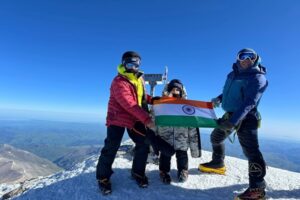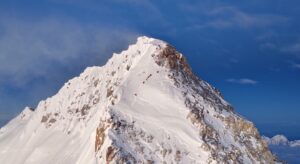Eleven people have died so far on six 8000’ers in Nepal, even before the usual weather window opens between May 20 and 25, when most climbers head for the summits.
That statistic is really too much, considering that no storm has caught teams near the summit, as on Everest in 1996; there have been no avalanches or falling seracs, as in 2014 in the Khumbu Icefall; and nor has an earthquake shaken loose the mountain, as in 2015.
In fact, only two of the deaths this season were clearly an accident: Phujung Bhote Sherpa fell to his death in a crevasse while fixing ropes on Cho Oyu and Irish climber Seamus Lawless slipped and fell near the Balcony on the south side of Everest.
In the second case, it is hard to tell what went wrong on a section which is usually sewn with ropes: a gear failure? an error when clipping to the ropes due to exhaustion or AMS? Significantly, Lawless’s has been the only accident on Everest itself. The only other fatality was Indian Ravi Thakar, who was found dead in his tent at the South Col.

Wi Kin Chin at Annapurna BC after his rescue. Photo: Dawa Sherpa
This suggests that while risks are inherent to mountaineering, climbers are not dying in accidents but from edema, exhaustion or, as frequently described, “exposure”, which presumably means hypothermia.
We also note that Everest, by far the most populated of the 8000’ers, ranks rather low on the casualty list. Most bad news this season has come from Kangchenjunga, Makalu and Annapurna. These three used to be among the loneliest of Nepal’s 8000’ers, due to their technical difficulty and size (in the two first cases) and the avalanche hazard on Annapurna. This year, by contrast, all three have seen an unusual number of summits.
This may be the key to understanding what’s going so terribly wrong on the roof of the world. In his article on the recent fatalities, Alan Arnette sensibly points out three reasons: greed, ignorance and ego. However, egoistic, inexperienced climbers have been around the Himalaya for quite a while, especially on Everest. The difference may be that nowadays, guided climbs have spread to other 8000’ers, where logistics have not been as perfected as on Everest.
Everest discredited
The last few years have seen a shift in Himalayan trends. Nowadays, the general media depicts Everest as an overcrowded circus of vanity, littered with garbage and corpses, and tamed by ropes, Sherpas and bottled oxygen. Sponsors, sensitive to the bad press, have retreated from funding expeditions. Yet as the highest summit on Earth, Everest still attracts many well-off clients willing to pay big bucks to plant their feet above every other human being.
Agencies have sprung up to cater to this upscale market, and their support improves with every season: from extensive use of oxygen, chopper flights up and down the valley, personal Sherpas, fixed ropes and luxury camps from bottom to top. All this gives not only a more comfortable climb, but a safer one. It is now easier than ever to help down afflicted climbers, treat them and evacuate them.

Everest Base Camp, a nylon and canvas town. Photo: Lakpa Sherpa
But what about those neither well-heeled enough to join a five-star Everest expedition nor skilled enough to attempt new routes, isolated faces or off-season climbs, which could still tempt some sponsors?
For those, the market has responded with what could be called the “Everestification” of the other 8000’ers. It began on Manaslu, which has turned into a prime post-monsoon option. This has now spread to the other peaks, using the same distinctive tactics as on Everest: Large teams of Sherpas supply camps and fix ropes to the very summit, while the climbers/clients wait just below. For example, on Kangchenjunga last week, a big group of climbers waited in Camp 4 until the Sherpas finished rope-fixing.
This way, the expensive, much-maligned Everest is replaced by other peaks with prestigious tags like “8,000m”, “difficult” or “dangerous”. All for less money, and with, supposedly, the same safety checks in place.
Two for one
Such tactics permit all climbers to use fixed ropes and follow a packed trail, whether they have signed up for a fully supplied expedition or are just so-called independent climbers using Base Camp services on a shared permit. However, the notion of an independent climber as self-sufficient is becoming less and less accurate. No matter if you’re a veteran with several 8000’ers under your belt, an alpine speed climbing specialist or a total Himalayan newbie, you basically join the line.
Furthermore, those who feel that bagging a single peak is not distinctive enough may add a second summit, taking advantage of double permits, regular airlifts between Base Camps and the acclimatization achieved on the first peak. Not a few Everesters have mutated into collectors of 8000’ers, via double-headers, combining spring and fall seasons, or targeting speed records by flying from Base Camp to Base Camp, such as Nirmal Purba and Sergi Mingote.
As a result, we see Everest-like summit crowds on all the 8,000’ers, with everyone racing for the top as soon as ropes and weather permit. Rope-fixing Sherpas are always first to top out, then the line of foreign climbers in what sometimes turns into a chaotic, save-yourself descent. Missing climbers are often noticed only much later, when someone mentions that a certain person isn’t in BC or in one of the altitude camps.
Such was the case of Annapurna, where a surprising 30 summits came during the season’s first weather window. Wi Kin Chin of Malaysia was one of the successful climbers but he became sick or weak during the descent. He spent 40 hours alone high on the mountain, was eventually rescued but later died in hospital. After Annapurna, Chin had planned to attempt Kangchenjunga.

The “Great Black” pyramid of Makalu. Photo: Seven Summit Treks
Too much comfort can kill you
Ambitious plans look easier at home than at 8,000m, where a lot can go wrong. For instance, some bring a minimal amount of “medicinal” O2 just in case, but this proves far from enough once the climber decides to draw from it during the climb. All kind of illnesses, exhaustion and dehydration, or jammed or missing fixed ropes, can turn deadly if a climber does not have the experience to deal with them. And a significant percentage of clients are unprepared and unskilled: Many, we read, first learn how to strap on crampons in Base Camp. An Argentinean climber on Kangchenjunga complained that he was one of the few who could actually use an ice axe.
Even without sponsors, many put a great deal of pressure on their own shoulders by updating continuously on social media. Climbing at that level requires full focus on the challenge, not on the number of Instagram likes achieved per day.
Ironically, the worst scenario may open up if the climb goes swimmingly until summit day. Many 20th century Himalayan rookies reached Base Camp full of dreams and motivation, but then faced heavy loads, cold, thirst and thin air. Many quit after a week, before even reaching the higher camps. That cost them the summit but taught them lessons and possibly saved their lives.
Today, this same rookie basks in a comfortable camp pitched and supplied for him, sips limitless O2 from Camp 2 onward, has meals cooked and ice melted for tea, is not bothered with decision-making, breaks no trail through hip-deep snow and just clips onto a rope. Such pampering will typically allow him to reach the upper sections before he realizes just how high up he is and how rough things really are up there, especially during a long, excruciatingly hard descent on weary legs.
Once in the mythical death zone, anything can kill you, including oxygen when a regulator fails, ropes when they snap, climbing mates when they can be of no help, and especially bad decisions, when you blithely soldier on, not realizing that your body is screaming at you to turn back.





